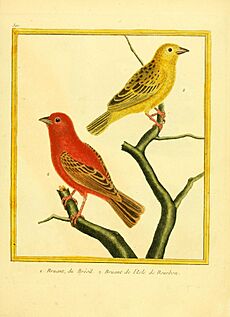Réunion fody facts for kids
Quick facts for kids Réunion fody |
|
|---|---|
| Conservation status | |
| Scientific classification | |
| Genus: |
Foudia
|
| Species: |
delloni
|
The Réunion fody (Foudia delloni) was a small bird that lived only on the island of Réunion. This island is part of the Mascarene Islands in the Indian Ocean. The Réunion fody belonged to the family of weavers, which are known for building amazing nests. Sadly, this bird is now extinct, meaning it no longer exists anywhere in the world.
How Scientists Study the Réunion Fody

Scientists use a system called taxonomy to name and group living things. This helps them understand how different species are related. The Réunion fody was first mentioned by a traveler named Gabriel Dellon. Another mention came in 1674 from a person named Dubois.
No museum specimens of this bird exist today. This means scientists do not have a preserved body to study. Despite this, two scientists, Anthony Cheke and Julian Pender Hume, officially described it as a new species in 2008. They wrote about it in their book Lost Land of the Dodo.
Before 2008, some people thought a bird called Foudia bruante was the Réunion fody. However, Cheke and Hume later suggested that Foudia bruante might just be a different color of the red fody. The red fody was brought to Réunion about 100 years after the Réunion fody was first discovered.
What the Réunion Fody Looked Like
The Réunion fody was about the same size as a common house sparrow. The male birds had very bright colors when they were ready to breed. Their head, neck, throat, and the underside of their wings were a bright red. Their back and tail feathers were brown. Their belly was a pale, light color.
The female birds and young males looked a bit different. Their heads were brown. Their necks and wings had red feathers. Their throats were a pale brown color.
Why the Réunion Fody Disappeared
The Réunion fody was once very common on Réunion Island. People even described it as a "pest" because it would eat and destroy entire crops. This means it caused problems for farmers.
However, the bird was last seen shortly after the year 1672. The main reason for its disappearance was likely predation. This means other animals hunted and ate them. Rats, which were brought to the island by ships, probably hunted these birds and their eggs. This led to the Réunion fody becoming extinct.


